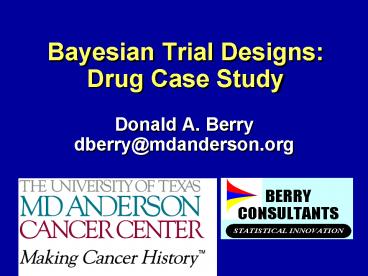Bayesian Trial Designs: Drug Case Study - PowerPoint PPT Presentation
1 / 36
Title: Bayesian Trial Designs: Drug Case Study
1
Bayesian Trial Designs Drug Case Study
- Donald A. Berry
- dberry_at_mdanderson.org
2
Outline
- Some history
- Why Bayes?
- Adaptive designs
- Case study
3
(No Transcript)
4
2004 JHU/FDA WorkshopCan Bayesian Approaches
to Studying New Treatments Improve Regulatory
Decision-Making?
- www.prous.com/bayesian2004
- www.cfsan.fda.gov/frf/ bayesdl.html
5
Upcoming in 2005
- Special issue of Clinical Trials
- Bayesian Clinical TrialsNature Reviews Drug
Discovery
6
Selected history of Bayesian trials
- Medical devices (30)
- 200 at M.D. Anderson (Phase I, II, I/II)
- Cancer Leukemia Group B
- Pharma
- ASTIN (Pfizer)
- Pravigard PAC (BMS)
- Other
- Decision analysis (go to phase III?)
7
Why Bayes?
- On-line learning (ideal for adapting)
- Predictive probabilities (including modeling
outcome relationships) - Synthesis (via hierarchical modeling, for example)
8
PREDICTIVE PROBABILITIES
- Critical component of experimental design
- In monitoring trials
9
Herceptin in neoadjuvant BC
- Endpoint tumor response
- Balanced randomized, H C
- Sample size planned 164
- Interim results after n 34
- Control 4/16 25
- Herceptin 12/18 67
- Not unexpected (prior?)
- Predictive probab of stat sig 95
- DMC stopped the trial
- ASCO and JCOreactions
10
ADAPTIVE DESIGNS Approach and Methodology
- Look at the accumulating data
- Update probabilities
- Find predictive probabilities
- Use backward induction
- Simulate to find false positive rate and
statistical power
11
Adaptive strategies
- Stop early (or late!)
- Futility
- Success
- Change doses
- Add arms (e.g., combos)
- Drop arms
- Seamless phases
12
Goals
- Learn faster More efficient trials
- More efficient drug/device development
- Better treatment of patients in clinical trials
13
ADAPTIVE RANDOMIZATIONGiles, et al JCO (2003)
- Troxacitabine (T) in acute myeloid leukemia (AML)
combined with cytarabine (A) or idarubicin (I) - Adaptive randomization to IA vs TA vs TI
- Max n 75
- End point Time to CR (lt 50 days)
14
Adaptive Randomization
- Assign 1/3 to IA (standard) throughout (until
only 2 arms) - Adaptive to TA and TI based on current
probability gt IA - Results ?
15
(No Transcript)
16
Drop TI
Compare n 75
17
Summary of results
- CR lt 50 days
- IA 10/18 56
- TA 3/11 27
- TI 0/5 0
- Criticisms . . .
18
Consequences of Bayesian Adaptive Approach
- Fundamental change in way we do medical research
- More rapid progress
- Well get the dose right!
- Better treatment of patients
- . . . at less cost
19
CASE STUDY PHASE III TRIAL
- Dichotomous endpoint
- Q P(pE gt pSdata)
- Min n 150 Max n 600
- 11 randomize 1st 50, then assign to arm E with
probability Q - Except that 0.2 P(assign E) 0.8
Small company!
20
Recommendation to DSMB to
- Stop for superiority if Q 0.99
- Stop accrual for futility if P(pE pS lt
0.10data) gt PF - PF depends on current n . . .
21
PF
22
Common prior density for pE pS
- Independent
- Reasonably non-informative
- Mean 0.30
- SD 0.20
23
(No Transcript)
24
Updating
- After 20 patients on each arm
- 8/20 responses on arm S
- 12/20 responses on arm E
25
Q 0.79
26
Assumptions
- Accrual 10/month
- 50-day delay to assess response
27
Need to stratify. But how?
- Suppose probability assign to experimental arm
is 30, with these data . . .
28
(No Transcript)
29
One simulation pS 0.30, pE 0.45
Superiority boundary
Final Std 12/38 19/60
20/65 Exp 38/83 82/167 87/178
30
One simulation pE pS 0.30
Futility boundary
9 mos. End Final Std 8/39
15/57 18/68 Exp 11/42 32/81 22/87
31
Operating characteristics
32
FDA Why do this? Whats the advantage?
- Enthusiasm of patients investigators
- Comparison with standard design . . .
33
Adaptive vs tailored balanced design w/same
false-positive rate power (Mean number patients
by arm)
34
FDA
- Use flat priors
- Error size to 0.025
- Other null hypotheses
- We fixed all willing to modify as necessary
35
The rest of the story
- PIs on board
- CRO in place
- IRBs approved
- FDA nixed!
36
Outline
- Some history
- Why Bayes?
- Adaptive designs
- Case study































